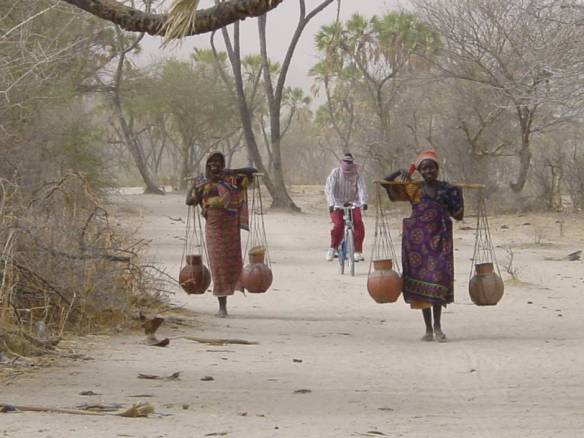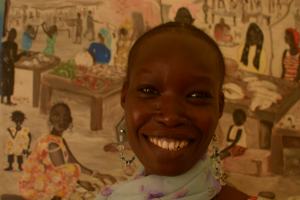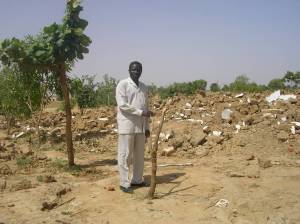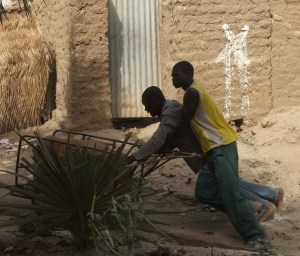 Cameroonian music is famous in West and Central Africa. The Makossa rhythm makes one dance so well. Rhythm is like beer, and still the hunger for freedom. Dance makes man feel free. Dance and music hide the illusion of freedom. Music and beer are allowed as long as they are not leading to criticism about the regime. But songs can bite! The recent death of artists tells a different story. We meet George in Douala. He is one of the ‘combatants’, member of the opposition party SDF, critical about the regime, critical about the role of France in Cameroon. ‘They keep the regime going’. He follows the critical music scene and relates the last suspicious deaths of artists: La Pirogue de Banga was imprisoned and died later in the USA where he was given asylum. It is told that he died of the maltreatment of his cancer in prison, or that he was poisoned. And the writer Charles Atena Eyene died a few weeks ago, also under suspicious circumstances, and Prof. Pius Ottou, and Pius Njawe…. Being an artist in Cameroon is not safe.
Cameroonian music is famous in West and Central Africa. The Makossa rhythm makes one dance so well. Rhythm is like beer, and still the hunger for freedom. Dance makes man feel free. Dance and music hide the illusion of freedom. Music and beer are allowed as long as they are not leading to criticism about the regime. But songs can bite! The recent death of artists tells a different story. We meet George in Douala. He is one of the ‘combatants’, member of the opposition party SDF, critical about the regime, critical about the role of France in Cameroon. ‘They keep the regime going’. He follows the critical music scene and relates the last suspicious deaths of artists: La Pirogue de Banga was imprisoned and died later in the USA where he was given asylum. It is told that he died of the maltreatment of his cancer in prison, or that he was poisoned. And the writer Charles Atena Eyene died a few weeks ago, also under suspicious circumstances, and Prof. Pius Ottou, and Pius Njawe…. Being an artist in Cameroon is not safe.
 Izmo was present at the SLAM festival organized by Croquemort in N’Djamena a few weeks ago. He is an experienced artist, a rapper-slammeur. He is a good friend of Croquemort whose music he adores, and whose vocation he shares. In N’Djamena we spent some late night-hours together in the popular disco in the neighbourhood Moursal. He was drinking his beer, while I was dancing. We exchanged some words and sympathized. He is a giant, 1 meter 98 centimeter, with Rasta hair, and a very charismatic personality. His voice is magic. As he explains: ‘my voice is just there’, no schooling. He holds a BA in Law that did not give him access to a job. Since eight years he is into song-writing and music composing; he is now 30 years old.
Izmo was present at the SLAM festival organized by Croquemort in N’Djamena a few weeks ago. He is an experienced artist, a rapper-slammeur. He is a good friend of Croquemort whose music he adores, and whose vocation he shares. In N’Djamena we spent some late night-hours together in the popular disco in the neighbourhood Moursal. He was drinking his beer, while I was dancing. We exchanged some words and sympathized. He is a giant, 1 meter 98 centimeter, with Rasta hair, and a very charismatic personality. His voice is magic. As he explains: ‘my voice is just there’, no schooling. He holds a BA in Law that did not give him access to a job. Since eight years he is into song-writing and music composing; he is now 30 years old.
Rotary members from Congo
We met again in Yaoundé on 8 April and he invited us to Emergence, a bar with life music. A small band was playing all kinds of songs, both African and other, not per se his nor my taste, but technically well done, which is enough for the techno musician he is. Being there also seemed an anomaly. The visitors to the bar were the relatively, sometimes ugly, rich who Ismael considers with a certain pity. Next to us a group of Rotary-Congo members were enjoying their evening. They were in Yaoundé for a Rotary meeting, spending money on poverty, and coming to these chique bars to dance with the Cameroonian girls they invited. These girls seemed rather non-interested in the fat men from Congo. Izmo does not need their money. He considers them part of the problems his songs are about.
Banal, shocking deaths
The next day we visited Izmo in ‘his quarter’, where he and his friends have a studio. It is here that he creates. These days he has been occupied with composing music for the new CD of Croquemort that will be launched mid-May.
Izmo is born out of wedlock. At the age of seven, he had to accept the death of his father. His father left Izmo three half-brothers from the marriage with his legal wife. These three brothers all left for the USA and it has been years since he heard from them. Izmo admires his mother, who tragically passed away a few years ago. During her working life as a nurse she took care of psychiatric patients. After retirement she turned mad herself, which became her death. She (also a giant, 1,84 meter) ran on the street in Douala, foolish and wild, people attacked her and she was killed by the mob. At that moment Izmo was in town for a concert. He found his mother’s body in the street, still warm. A shocking death of the woman he loved most in his life.
His daughter too died a tragic death in 2011: she needed urgent help in the hospital, but the main roads were closed because the president was passing. A sick child was no reason to let them cross. His daughter died in his arms.
Banal deaths are still common in Cameroon, but these deaths should not be forgotten. Izmo’s songs make us ponder.
These events have informed Izmo’s life, and music that talks critically and emotionally about the present day, the everyday tragic that is so common for citizens in the shadows of the world. His explanations about life and the injustices in his neighborhood, country and the world in general, are inspired by theories that embrace anti-colonial ideas, a form of Marxism, and foremost anger. It can be summarized as a sincere vocation of youth without chances.
 Movement of musicians
Movement of musicians
Ismael wants to reach out to the wider Cameroonian, African and why not global public, preferably to the youth; youth that should be the backbone of uprisings and revolution, of protest. But how does Izmo relate to the other youth, who are oriented on consumption, who long to go to Europe or the US, and imitate the soaps on TV? They come on holiday in Cameroon and show off their bling bling. ‘This can be considered another form of protest; despite all uncertainty they have been successful and survive well materially. Showing bling bling is also a protest against their subordinate condition.’ In fact Izmo and his friends and these bling bling youth send out the same message.
‘Masters of the Game’ is a label of music producer Alain Balibi, alias Faucon. The label is like a movement and unites engaged and radical musicians, like Valsero and Izmo le Rapologue. In contrast to Chadian musicians, these artists do not receive funding from the Centre Culturel Francais, instead they receive threat messages from the Government and some of their songs are forbidden on radio or TV.
Izmo is tired of it. He feels that after twelve years of hard work he is still caged by the Cameroonian state. He has been in contact with several Europeans who were all delighted by his music, but never helped him make a career. His friend states over and over again that his talent is ‘dying’ here…
He deserves a much broader audience.
Chanson: CARINE
Refrain:
Carine n’a que 16 ans et déjà meurtrie dans sa chair;
il parait qu’elle souffre d’un cancer ; chaque jour elle se rend
chez le médecin et reçoit des coups de bistouri dans le sein.
Première couplet:
Pour elle ce n’est plus qu’une histoire de secondes;
le temps se compte c’est une course contre la montre;
elle a perdu l’éclat de son tendre visage comme si on retirait un soleil à un paysage;
une tumeur lui vole sa jeunesse, ronge sa chair;
impossible de lui passer une caresse, son corps est une boule de feu comme dit Kery:
il n’y a que la tristesse que tu peux lire dans ses yeux.
Refrain (2x)
Deuxième couplet:
Ce matin, un brin de sourire dès le réveil, elle a le soutien de toute la famille à son chevet, sa situation n’a pas du tout changé;
déjà habituée au piqure de seringue après le déjeuner, Carine s’inquiète de la fortune qu’elle coute à ses parents, car l’instituteur a renvoyé son jeune frère de l’école hier faute d’argent;
tout se dépense entre les médicaments et les poches de sang. Souvent sa maman se cache pour pleurer, entre le docteur et elle il n’y a plus de secret. On se rapproche du jour J, puisque la petite étoile va s’ éteindre comme la flamme d’une bougie.
Refrain (2x)
Troisième couplet:
Aujourd’hui nous sommes une matinée du 15 Juin, et désormais la petite Carine se compte parmi les victimes du destin;
c’est la consternation après constat et avis du médecin. Dans ce monde il n’ y a que les anges qui laissent leurs plumes, tu as été si vaillante jusqu’à la dernière minute, va puisqu’on est juste des traces du temps si fragile et si frêle telles des feuilles balayées par le vent.
Refrain (3x)
Translation of CARINE
Chorus:
Carine is only 16 years old and already dying in her body
She is ailing with cancer, every day she goes to
the doctor and receives ‘shots of scalpel’ in her breast
Verse 1
For her it is not more than a history of a few seconds
Time is short; it is a race against the clock
She lost the brilliance of her tender face, as if the sun was removed from the landscape;
A tumor steals her youthfulness, and eats her flesh
It is impossible to caress her, her body being like a fire ball; as Kery told: there is only sadness that one can read in her eyes
Chorus 2X
Verse 2
This morning starts with a little hope, a little smile since awakening, with the support of the whole family at her bedside; her situation has not changed at all.
Already used to the bites of the vaccination needles, after lunch, Carine is worried about the fortune that her parents spend on her, while the teacher sent her younger brother away from school; Lack of money to pay the fees, because of the high costs for medicine and sacks of blood.
Often her mother hides crying.
Between the doctor and her there is no secret, instead they come closer every day, the little star will extinguish like a candle flame.
Chorus 2X
Verse 3
Today we live in the morning of June 15, when the petite Carine belongs to the victims of destiny;
In the dismay after the conclusion and advice of the doctor, in this world it is only angels who leave their feathers behind. You have been so brave, until the last minute, go…, we are just traces of time, so fragile and brittle like the leaves that dance with the wind.
Chorus 3X


 Putting women central
Putting women central



 Medicine student
Medicine student